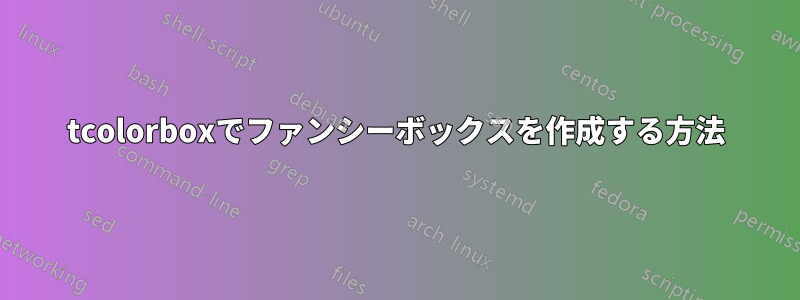
下のようなおしゃれな箱を作りたいです。
 しかし、これまでのところ、私は実際に必要なものではない以下の画像を作成することができました。
しかし、これまでのところ、私は実際に必要なものではない以下の画像を作成することができました。
 ムウェ
ムウェ
\documentclass{article}
\usepackage[many]{tcolorbox}
\tcbuselibrary{skins}
\newtcolorbox[auto counter,number within=section]{myex}[1][]{
before=\bigskip\centering,
after=\bigskip,
breakable,
enhanced,
arc=15pt,
colback=white,
fonttitle=\sffamily\bfseries,
title=Ex~\thetcbcounter,
frame hidden,
sharp corners,
rounded corners=southeast,
attach boxed title to top left,
boxed title style={
enhanced,
colframe=purple!65!blue,
colback=purple!65!blue,
arc=5pt,
borderline east={2pt}{6pt}{white},
borderline east={2pt}{2pt}{white},
bottomrule=0pt,
rightrule=0pt,
sharp corners,
},
interior style={},
overlay={
\draw[line width=1pt,purple!65!blue]([xshift=-3pt,yshift=.6cm]frame.north
west)--([xshift=-3pt]frame.south west);
\draw[rounded corners=20pt,line width=1pt,purple!65!blue] ([xshift=-
3pt]frame.south west) -- (frame.south east)--(frame.north east);
\draw ([yshift=.6cm]frame.south east)--(frame.north east)--
([xshift=10cm]frame.north west);
}
}
\begin{document}
\begin{myex}
What is meant by \textbf{electron affinity}.
\end{myex}
\end{document}
ご協力ありがとうございます
答え1
コード
\documentclass{article}
\usepackage{lipsum}
\usepackage[many]{tcolorbox}
\tcbuselibrary{skins}
\xdefinecolor{pBlue}{RGB}{102, 53, 153}
\newtcolorbox[auto counter, number within=section]{myex}[1][]{%
before=\bigskip\centering,
after=\bigskip,
breakable,
enhanced,
colback=white,
frame hidden,
sharp corners,
rounded corners=southeast,
arc=25pt,
fonttitle=\sffamily, % \bfseries,
title=Ex~\thetcbcounter,
attach boxed title to top left={xshift=5pt}, %, xshifttext=5pt},
boxed title style={%
enhanced,
colframe=pBlue,
colback=pBlue,
borderline east={1.5pt}{8pt}{white},
borderline east={1.5pt}{3.5pt}{white},
borderline east={3.5pt}{0pt}{white},
borderline east={2.75pt}{0.25pt}{pBlue!50},
borderline east={2.75pt}{-4pt}{pBlue!20},
bottomrule=0pt,
rightrule=5pt,
sharp corners,
},
interior style={},
overlay={%
\begin{scope}[line width=1.5pt, pBlue]
\fill[shade, bottom color=pBlue!30, top color=white]
([xshift=-30pt]frame.south east)
to[out=0, in=-90] ([yshift=30pt]frame.south east)
-- ([shift={(-1pt, 15pt)}]frame.south east)
to[out=-90, in=0] ([xshift=-25pt]frame.south east);
\draw
([shift={(-1pt, 19pt)}]frame.north west) coordinate (iniPoint)
-- ([xshift=-1pt]frame.south west)
-- ([xshift=-30pt]frame.south east)
to[out=0, in=-90] ([yshift=30pt]frame.south east)
-- (frame.north east) -- ++(-2.5, 0) coordinate (endPoint);
\draw (endPoint) -- ++(-3pt, 3pt) -- ++(-3pt, -3pt)
-- ++(3pt, -3pt) -- cycle;
\draw (iniPoint) -- ++(4pt, 0) -- ++(-8pt, 0);
\draw (iniPoint) ++(0, -10pt) -- ++(6pt, 0) -- ++(-12pt, 0);
\draw (iniPoint) ++(0, -14pt) -- ++(6pt, 0) -- ++(-12pt, 0);
\end{scope}
}
}
\begin{document}
\section{Test}
\begin{myex}
What is meant by \textbf{electron affinity}:
\lipsum[1]
\end{myex}
\end{document}



